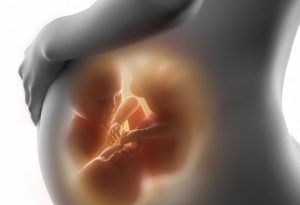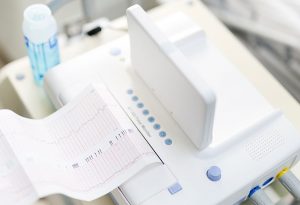In this Article
The third trimester is a time that can be a filled with mixed emotions. You could be filled with excitement about the baby’s arrival and then be anxious about the baby’s health as well. What if something goes wrong at the last minute? Will everything go as planned? The cardiotocography is a technique that may help in alleviating some of your fears.
What is Cardiotocography?
A cardiotocography is a technique that is used to monitor the heartbeat of the foetus along with keeping a check on uterine contractions. This can be deciphered from the name itself – cardio (heart) toco (uterine contractions) and graph (recording). A CTG Test during pregnancy is usually performed during the third trimester as well as during labour. The correct utilization of this test can help prevent the baby from dying due to a shortage of oxygen.
Why Pregnant Women Need CTG
A CTG isn’t mandatory and low-risk pregnancies don’t require this. However, there are medical situations where the baby may be at risk such as:
- Your blood pressure is on the higher side
- You have been given medication to increase the speed of labour
- You have been given an epidural to help you manage the pain during contractions
- You have passed fresh blood during the labour process
- You have ailments such as diabetes or hypertension
- Your amniotic fluid is lower than the safe amount
- You are expecting twins
- There is a suspected reduction in placenta which may reduce the amount of blood your baby receives
- You feel as though your baby’s movements are not the same, they have become erratic or slower than usual
- Your baby is in an unusual position
- Your temperature is on the higher side
- The foetus has passed meconium (bowel movement) in the amniotic fluid. While this is not dangerous in itself, it can become dangerous if inhaled by the baby.

What Happens in Cardiotocography?
- Internal Monitoring:This form of monitoring involves putting the device inside the vagina which means a certain amount of cervical dilation would be required. The device (an electrode) is placed close to the scalp of the foetus to get a reading. This form of monitoring is uncommon and is performed if there is difficulty in capturing the heartbeat in external monitoring. However, it is more accurate when compared to external monitoring and so may be the preferred method in complicated cases.
- External Monitoring:This is the most common form of testing and is done by placing the equipment on the abdomen of the mother. It consists of an elastic belt with two round plate the size of a cricket ball. One plate emits an ultrasound frequency which is used to detect the baby’s heartbeat. The other plate is used to record the pressure on the mother’s abdomen along with the contractions. The belt is connected to a device that is used to read the signals that are being registered. Sometimes a gel may be applied to get a stronger signal. The reading by the device is given in the form of a loud beating sound. As some pregnant women can find this discomforting or distracting, there is a volume knob that can be used to lower the sound produced. Prior to going into labour, the mother would be asked to press a button on the machine each time she feels the baby move.
How Does CTG Work?
CTG employs sound waves to help detect and monitor your baby’s heartbeat. Soundwaves in the form of ultrasound are used for a variety of medical purposes such as locating solid gallstones or blood clots. When ultrasound is targeted in a direction, it moves freely through fluids and soft tissue. However, it bounces back when it hits any solid objects and this shows up on the recording device. With this, doctors are able to identify what is inside the body without opening it up. Additionally, it can differentiate between densities (meaning it can tell the difference between bones, muscles and other parts of the body). CTG employs Doppler, a type of ultrasound that helps in studying moving objects. This becomes relevant in detecting the heartbeat of the baby.
What Can Cardiotocography Show?
Baby’s have a higher than average heart rate of 110-160 heartbeats every minute. Anything higher or lower than that may be indicative of a problem in your baby’s health. The CTG helps detect anomalies that may occur during contractions. The heartbeat during this time has a set pattern and specific changes may be indicative of a problem. If your doctor is convinced that the issue may jeopardize the pregnancy, they would start an emergency caesarean section or assisted delivery.

Complications or Side Effects of CTG
CTG has two main advantages that have made it popular, namely its non-ionizing properties and its non-invasive nature. Unlike X rays, ultrasound does not employ any ionizing radiation to take a look inside the body. This means that you and your child will have no risk of genetic damage. Non-invasive means that the procedure does not introduce instruments inside the body. For example, a Caesarean is highly invasive.
However, CTG does have a few drawbacks such as:
- Some of the CTG machine models offer poor mobility during labour which can be inconvenient.
- Rampant use of CTG may lead to situations where Caesarean or assisted delivery may be done even though it may not be needed.
- Pregnant women with contagious diseases such as HIV, Herpes and Hepatitis B risk passing on the infection to their child. In such cases, internal monitoring is strictly prohibited.
- The reading is not precise and can even show a dead foetus as alive. This happens when the sensor captures the pulse of the mother’s abdominal aorta and mistakes it for a heartbeat.
How to Read CTG?
During CTG monitoring in pregnancy, the heart rate of the baby is constantly checked for any anomalies. The machine is equipped with a printer which allows you to have a look at the heart rate yourself. Below is a table which shows the range of what the registered values indicate.
| Reading | Heart Beat per minute |
| Safe | 110-160 |
| Warning | 100-109 or 161-180 |
| Threatening | Lower than 100 or more than 180 |
However, an immediate action such as Caesarean or assisted delivery based on these readings isn’t always recommended. Your doctor would usually follow up with a biophysical profile of the foetus to be certain.
Please note that the readings are not precise so do not be alarmed if you find anomaly the first time. There could be a number of reasons such as your baby falling asleep during the test. In such instances, either the baby is woken up using a stimulator or the test is performed after a while. However, there may be instances when it can alert the doctor of a failing pregnancy. In such instances, an emergency procedure can be performed and save the life of your child.









